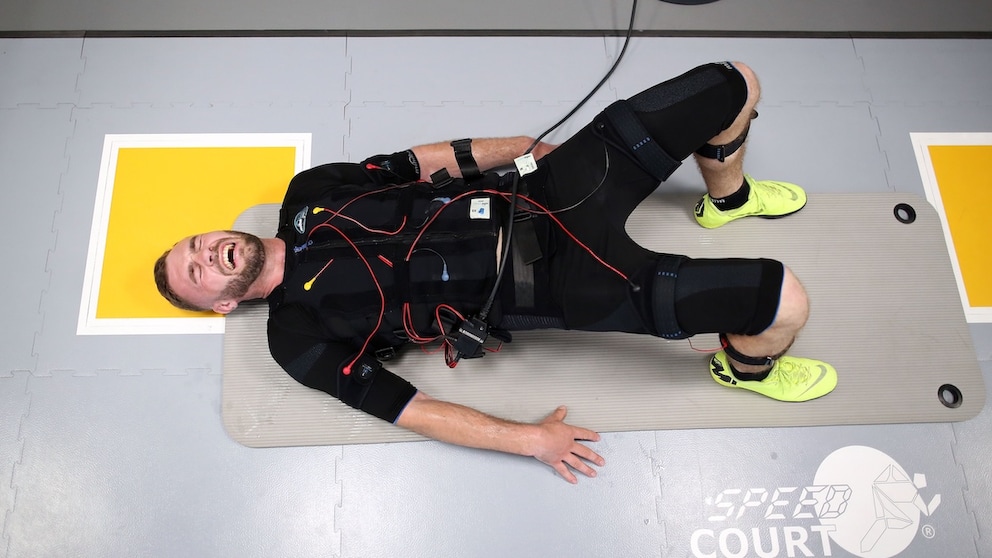April 16, 2025, 11:18 am | Read time: 4 minutes
A 20-minute workout per week is said to be enough to build muscle and improve fitness—it sounds almost too good to be true. EMS studios promote quick results, but how effective is electrical muscle stimulation really? We explain how EMS training works, who it is suitable for, and what its limitations are.
Electro-Myo-Stimulation (EMS) has been used in rehabilitation since the 1970s and has now established itself as a training method in the fitness sector. But does EMS replace traditional strength training? Who is this method suitable for—and who is it not? A look at the effectiveness, safety, and costs.
Overview
How Does It Work?
Originally from medicine, electrical muscle stimulation has been used for years in rehabilitation. For example, this special training method is applied to muscular injuries such as strains or fiber tears to shorten the healing process and rebuild weakened muscles after surgery. Targeted electrical impulses stimulate muscle groups and cause them to contract, promoting muscle growth.
During EMS training, you wear special clothing with integrated electrodes connected to a control device. Trainers can adjust the impulse strength for different muscle groups individually. In the first session, the comfortable current strength is determined and saved for future training. The impulses should be perceived as a slight tingling sensation but should not cause pain.
EMS Does Not Replace Traditional Training
A common misconception is the belief that EMS training works without any effort. In reality, participants are guided by a trainer through various exercises during the session, where muscles are consciously tensed and relaxed. These exercises, which are usually easy, become significantly more challenging due to the additional stimulation—intense sweating is guaranteed.
One advantage of EMS training is that it also reaches deep muscle groups. This leads to severe muscle soreness, especially for beginners. Since the strain on the muscles is high, EMS should be performed no more than once a week to ensure adequate recovery.
EMS No More Than Once a Week
This is the great advantage of this training: A session usually lasts 20 minutes—and that’s per week. More than once weekly is not recommended due to the particularly long recovery time. If studios offer two sessions per week, they are usually one strength and one endurance training session spaced several days apart.
The effectiveness of EMS depends on individual training goals. A single training session per week can already bring initial success, but those aiming for significant muscle or strength gains may need additional training.
It Is Worthwhile for These People
EMS training is particularly interesting for people with little time or low motivation for regular workouts. This was the result of a large evaluation of various studies on the effectiveness of this training method, conducted in collaboration between the University of Erlangen-Nuremberg, the Technical University of Kaiserslautern, and the German Sport University in Cologne.1 The analysis showed that for most participants, muscle mass and strength increased through EMS training, and complaints such as lower back pain subsided.
On the other hand, EMS may be less attractive for already well-trained athletes who like to push their physical limits. However, those who value close supervision or need extra motivation can use EMS as a useful supplement to regular training.
Is Electro-Myo-Stimulation Safe?
The aforementioned study analysis by German universities also examined the safety of EMS. According to the researchers, none of the studies reported any adverse side effects among participants, even though some of the investigations lasted up to twelve months. In only four out of 23 evaluated studies did a participant drop out early because they felt uncomfortable during EMS training.
However, as with any training, correct application is crucial. Excessive muscle strain can lead to damage, which is why EMS should always be conducted under professional supervision.
It is fundamentally important to address medical questions before starting EMS training. Guidelines indicate where it is not possible or is limited, such as in cases of cancer, acute injuries, open wounds, and pregnancy.

How Deadly Diabetes Can Be

How to Train Strength and Endurance with Mountain Climbers

How Effective Is EMS Training, and Who Is It Suitable For?
The Costs of EMS Training
A major hurdle in EMS training is the price. Although costs have decreased due to competition among many providers, you still have to expect at least 25 euros for a 20-minute session. For comparison, this is often the monthly membership fee in a budget gym. So, if you want to do EMS, you should expect monthly costs of around 100 euros.
Thus, the target audience is quickly limited. However, if you know you can’t motivate yourself to go to the gym, are otherwise a couch potato, and can afford it, you can indulge in EMS training.

